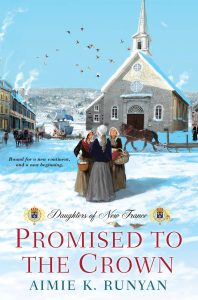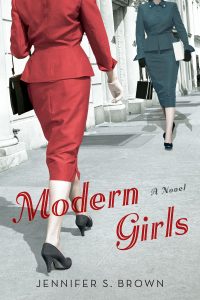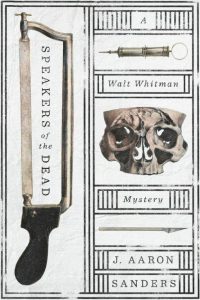New Voices: Annabel Abbs, Jennifer S. Brown, Aimie K. Runyan & J. Aaron Sanders
Myfanwy Cook
 Inviting us to share their catalyst moments are debut novelists Annabel Abbs, Jennifer S. Brown, Aimie K. Runyan and J. Aaron Sanders.
Inviting us to share their catalyst moments are debut novelists Annabel Abbs, Jennifer S. Brown, Aimie K. Runyan and J. Aaron Sanders.
Annabel Abbs describes her novel The Joyce Girl (Impress Books, 2016) as “a small edifice built on four founding blocks – each of which was a book. Without any one of these,” she says, “I may never have written it. The first book was the original source of inspiration. Dotter of her Father’s Eyes, by Mary and Bryan Talbot, won the 2012 Costa Biography award and was the first graphic novel I’d ever read. It tells two stories, one of which is a potted account of James Joyce’s daughter, Lucia, a pioneering modern dancer in 1920s Paris. Graphic novels are inevitably restricted, and, although marvellous, it left me with many questions.”
Abbs continues: “I was horrified that I’d studied Joyce at University but knew nothing of his daughter. I turned to the only biography of Lucia and read it twice. Here I learned that all of Lucia’s letters, medical records, and diaries had been destroyed. Not only that, but letters written about her and to her had also been destroyed. She underwent early psychoanalysis with Carl Jung – but he, too, had destroyed all his notes and records. There was no record of the affairs she’d claimed to have with Samuel Beckett and Alexander Calder. Everything was burned after she was committed to an asylum.”
She admits, “At the time I hadn’t planned to be a writer, but the treatment of Lucia moved and enraged me. Her biography was written by a Joycean scholar, and although it was meticulously researched, I felt it was inaccessible to the average reader. At the same time I read a novel about Virginia Woolf and her sister [Vanessa and Virginia] by Susan Sellers, whose writing style made me think I could approach a novel of Lucia in a similar way. I then read hundreds of reference books and finally produced a first draft – only to realise it read like a replica of Susan Sellers’ novel. Meanwhile I was reading Jessie Burton’s The Miniaturist – which helped me see that my novel was bereft of plot or pace.” Then, Abbs reports, “I sat down and rewrote the entire novel… which eventually bloomed into The Joyce Girl.”
 In contrast to Abbs’ novel, Promised to the Crown (Kensington, 2016) by Aimie K. Runyan “was a happy accident ten years in the making.” Runyan says: “I was taking a course in Canadian civilization for my graduate program, not out of a strong desire to learn about the subject, but because it was the course I needed at the right time. I also enrolled in a creative writing course that semester for the benefit of my own sanity, which kept me on the constant lookout for story ideas (I am also a firm believer in the power of deadlines). When my Canadian professor mentioned that Louis XIV paid for the passage of 770 women, known as the filles du roi, to go to his colony in Canada to marry settlers and populate Quebec, I immediately knew I had a story.”
In contrast to Abbs’ novel, Promised to the Crown (Kensington, 2016) by Aimie K. Runyan “was a happy accident ten years in the making.” Runyan says: “I was taking a course in Canadian civilization for my graduate program, not out of a strong desire to learn about the subject, but because it was the course I needed at the right time. I also enrolled in a creative writing course that semester for the benefit of my own sanity, which kept me on the constant lookout for story ideas (I am also a firm believer in the power of deadlines). When my Canadian professor mentioned that Louis XIV paid for the passage of 770 women, known as the filles du roi, to go to his colony in Canada to marry settlers and populate Quebec, I immediately knew I had a story.”
What impressed her, she says, was “that things were going fairly well in France at the time; these women were giving up the lives they knew in a country that was at the pinnacle of civilization and culture. They faced uncertain futures in a country they knew next to nothing about. They were told it was cold, there were dangerous natives, and that the men they would marry had become a bit ‘rough around the edges’ after years in the Canadian wild. These women accepted the challenge placed before them and became mothers to a nation. Two-thirds of all people of French Canadian ancestry, myself included, are descended from one or more of these brave women.”
“Years later,” Runyan continues, “I had the opportunity to spend several months in Quebec researching for my thesis on these women, and squirrelled away documents I could use for the novel I yearned to write. But, as is the frequent tale, my little story sat in a drawer (ok, hard drive) for ten years as I established my career as a teacher and became a wife and mother. One day, when my youngest was finally sleeping through the night and shreds of sanity came creeping back, I gave myself permission to sit and continue their story.”
 Jennifer S. Brown, author of Modern Girls (NAL, 2016) finds that “history comes alive” for her when, she says, “I can place myself in it. This is why I love historical fiction, and it’s also why I have a passion for researching my family’s genealogy. While collecting names for the family tree can be a fun game, I’m more interested in the stories behind the names. Finding pieces of evidence – old letters, buried in a cousin’s basement, written between great-grandparents; newspaper articles about long-gone family members; ship manifests that illuminate professions and hometowns – helps me imagine fully realized people. As a writer, though, genealogy is more than a pastime; it’s an inspiration for my fiction.”
Jennifer S. Brown, author of Modern Girls (NAL, 2016) finds that “history comes alive” for her when, she says, “I can place myself in it. This is why I love historical fiction, and it’s also why I have a passion for researching my family’s genealogy. While collecting names for the family tree can be a fun game, I’m more interested in the stories behind the names. Finding pieces of evidence – old letters, buried in a cousin’s basement, written between great-grandparents; newspaper articles about long-gone family members; ship manifests that illuminate professions and hometowns – helps me imagine fully realized people. As a writer, though, genealogy is more than a pastime; it’s an inspiration for my fiction.”
In order to learn more about her family, Brown pressed her father for stories. “He told me his great-grandmother had a pregnancy during the Depression that she couldn’t afford. My writerly instincts kicked in, and his grandmother’s story transformed into two fictional women with unwanted pregnancies, the heart of Modern Girls.”
Brown elaborates, “The two women – immigrant Rose and her American-born daughter, Dottie – are based on my own great-grandmother (not coincidentally named Rose) and my grandmother, Bessie. The fictional characters are infused with details from stories my father told me. While Bessie wasn’t pregnant before her marriage, she was a high-school track star, a whiz with numbers, and attended Camp Eden. Her mother, my great-grandmother, was an intractable woman, ruling the house with an iron fist. Rose made sure the Jewish traditions were maintained in her home, even as everyone else in the family ignored them whenever her sharp eye was turned elsewhere. No one was sure of Rose’s age, because it was a poorly kept secret that she lied about it to appear younger than her husband.
“So while Dottie and Rose may be fictional, in many ways they are a tribute to the women who came before me. They keep my family alive in my heart.”
 The idea for J. Aaron Sanders’ Speakers of the Dead (Plume, 2016) came while he was reading Justin Kaplan’s biography of Walt Whitman. “In it, I happened upon the most amazing story: Whitman left home at age 12 to be a printer’s devil for a man named Samuel Clement. Being homesick, Whitman looked to Clement as a father figure, and so he was shocked when Clement was arrested for digging up the corpse of the recently deceased Quaker prophet, Elias Hicks. This story so affected Whitman that he wrote about it in the Brooklyn Daily Times in 1857, and perhaps reworked his adolescent, gruesome experience in the surreal poem The Sleepers.”
The idea for J. Aaron Sanders’ Speakers of the Dead (Plume, 2016) came while he was reading Justin Kaplan’s biography of Walt Whitman. “In it, I happened upon the most amazing story: Whitman left home at age 12 to be a printer’s devil for a man named Samuel Clement. Being homesick, Whitman looked to Clement as a father figure, and so he was shocked when Clement was arrested for digging up the corpse of the recently deceased Quaker prophet, Elias Hicks. This story so affected Whitman that he wrote about it in the Brooklyn Daily Times in 1857, and perhaps reworked his adolescent, gruesome experience in the surreal poem The Sleepers.”
Sanders decided, he says, “to set the novel in the early 1840s, when Walt Whitman was young and ambitious, and he was living a big life in New York City. He could kick ass if he needed to – and what I found fun, when writing the novel, was how human Walt became.
“At that time, Walt Whitman had just published a temperance novel, Franklin Evans, and was working on a follow-up he never finished called The Madman. I wanted to explore why. Research taught me that this was around the time of the unsolved Mary Rogers murder, the rise of yellow journalism, body snatching for anatomical dissection, disease, immigration problems, and political corruption – a transformative time for New York City.”
“For each of these narrative strands,” Sanders says, “I used a corresponding historical character (Edgar Allan Poe/Mary Rogers, James Gordon Bennett/yellow journalism, Samuel Clement/body snatching, Elizabeth Blackwell/anatomical dissection, and Isaiah Rynders/immigration and politics). I never felt the fictional elements intruding on the history, but I did have to bend history to bring all these narrative strands together. That’s what makes this book so fun.
“Speakers of the Dead,” Sanders explains, “is first and foremost a mystery novel. That said, I also wanted to write a novel that somehow documents the transformation of the young Walt Whitman into the Walt Whitman, the American Poet. I wanted to capture his ambition, his physicality, his capacity for love, and to imagine a set of fictional events that might begin to explain his poetic ability to capture all of America in Leaves of Grass.”
Undoubtedly, each of the four debut novelists has not only engaged deeply with their characters, but has also paid tribute to those who lived in the periods that they are writing about.
About the contributor: MYFANWY COOK is a devotee of the work of debut novelists and their ability to create new fiction from past facts and memories. Email (myfanwyc@btinternet.com) or tweet (twitter.com/MyfanwyCook) about debut novelists you have enjoyed reading.
______________________________________________
Published in Historical Novels Review | Issue 77, August 2016






